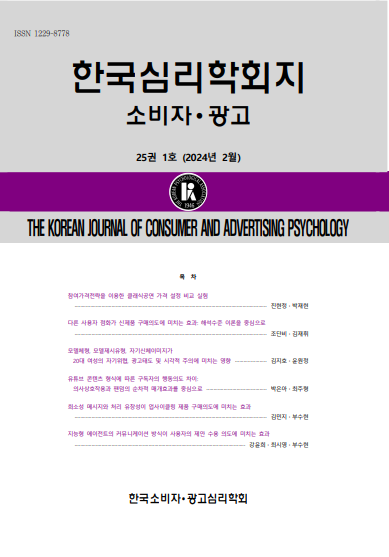open access
메뉴.png)
open access
메뉴 ISSN : 1229-8778
ISSN : 1229-8778
This study was conducted to identify how Facebook users’ levels of upward comparison with others and social support by mediating of self-esteem on life satisfaction. A survey was carried out on 1,332 male and female Facebook users in ages ranging from teens to fifties; the participants were residents of Seoul, Busan, Daejeon, Daegu and Gwangju. The study method used structural equation modelling, exploratory factor analysis and confirmatory factor analysis for reliability and validity testing, and hypothesis testing. The results showed that user’s upward comparison with others and social support had a significant effect on life satisfaction, and therefore Hypotheses 1 and 2 were supported. Hypothesis 3 and 4 suggesting user’s upward comparison with others and social support would effect on life satisfaction via self-esteem as an mediating variable were also supported. The results of this study are as follows. First, when Facebook users upward compare themselves with others, it lowers their self-esteem which in turn reduces their life satisfaction. In addition, when users have social support, they will have better self-esteem, which leads to higher life satisfaction. Finally, the implications, discussions and limitations of this study are presented.
The aims of this study were to examine the relationship between small luxury (self-reward, self-comfort, show-off) and dysfunctional consumption behavior (impulsive buying, compulsive buying) of college students and to confirm the mediating effect of self-control which acts as a deterrent factor in the process. The results of this study are summarized as follows: First, in the relationship between three small luxury motivations and self-control, self-reward did not show a significant relationship with self-control, but self-comfort and show-off reduced self-control significantly. Second, in the relationship between self-control and dysfunctional consumption behavior, self-control showed the function as a deterrent factor to reduce impulse buying and compulsive buying. Third, in the relationship between small luxury and dysfunctional consumption behavior, self-reward showed direct effect on both impulse buying and compulsive buying, but not all indirect effect through self-control. And, self-reward did not have a direct effect on impulse buying, only indirect effect through reduction of self-control, and direct and indirect effect on obsession buying. Especially, show-off showed indirect effect through the reduction of self-control as well as direct effect in both impulse buying and compulsive buying. The above results suggest that if ‘small luxury’, which is considered to provide satisfaction and pleasure to individuals who were under realistic economic constraints, is repeated without any other solution, it can be developed into dysfunctional consumption behavior through direct or indirect paths. In the discussion, we interpreted the because of the different influences of small luxury motivations to self-control, impulsive buying, and compulsive buying, and suggested for future research.
The purpose of this study was to investigate whether maximization and self-construal influences consumer’s product preference in self and other decision making. The experimental design of this study was 2(maximization: maximizers/satisficers)×2(self-construal: independent/interdependent)×{2(target: self/other)} 3-way mixed design. Target was a within-subjects variable. The results revealed that the effect of three-way interaction was significant and supported two hypotheses. First, it was demonstrated that maximizers maximize for both themselves and others regardless of self-construal subtypes. Interdependent satisficers on the other hand, maximize only for others and not for themselves much more significantly than independent satisficers. Additionally, the effect of two-way interaction revealed that there were significant differences between maximization and self-other, and between self-construal and self-other. More specifically, the results indicated that maximizers and satisficers made different choice in making decisions for themselves. There were also differences between independent and interdependent subjects when making decisions for themselves. Interdependent subjects also showed significant difference in self and other decision making.
This research investigates the role of emotion in the persuasion process by establishing a novel relationship between emotion and construal level. Built on cognitive appraisal theories, this research proposes that the certainty appraisal components of emotions exert a direct influence on an individual’s representation of information at a high versus low construal level. The findings indicate that individuals primed to experience a specific emotional state strongly associated with uncertainty construe behaviors or events at a high level while those primed to experience an emotional state strongly linked to certainty characterize behavior or events at a low level (Study 1). Such a fit (vs. nonfit) between an individual’s emotional state and the construal level at which product benefits in an advertising message are represented lead to a more favorable evaluation of the message and product. The findings of this research specifically suggest that individuals induced to feel happiness associated with certainty respond to ad messages described in terms of feasibility than desirability and that the opposite pattern would be found for those induced to feel fear associated with uncertainty. Accordingly, these outcomes occur because the certainty appraisal components of specific emotions significantly influence mental construal levels.
This research is consisted of two empirical studies. In study 1, it examined if consumers differ in their prediction of happiness of purchases depending of their product evaluation mode (i.e., joint evaluation mode vs. single evaluation mode). Study results suggest that under joint evaluation mode the predicted happiness increased as the level of product attributes increased but under single evaluation mode there is no difference of the predicted happiness regardless of the product attribute levels. This is found for both material and experiential products so that distinction bias is supported empirically. In study 2, the study investigated if there is differences in the proportion of the bucket list of material things and experiential things as well as the first bucket list item in line with the suggestion of socioemotional selectivity theory. Study results indicate that people prioritize experiential things compared to material things and list more experiential items in the bucket list when they perceive their time in life is limited.